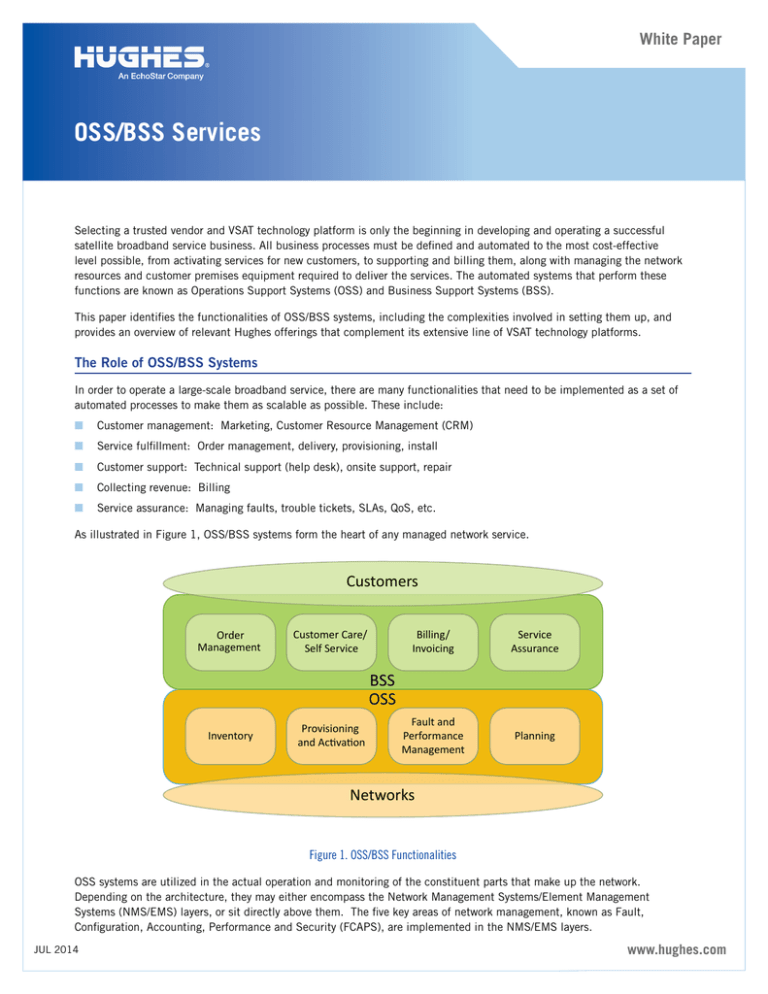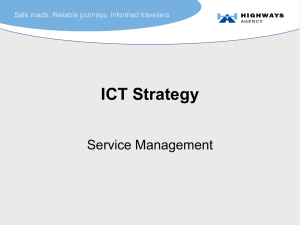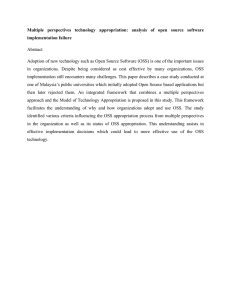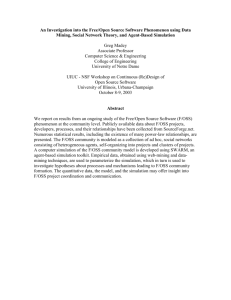
White Paper
OSS/BSS Services
Selecting a trusted vendor and VSAT technology platform is only the beginning in developing and operating a successful
satellite broadband service business. All business processes must be defined and automated to the most cost-effective
level possible, from activating services for new customers, to supporting and billing them, along with managing the network
resources and customer premises equipment required to deliver the services. The automated systems that perform these
functions are known as Operations Support Systems (OSS) and Business Support Systems (BSS).
This paper identifies the functionalities of OSS/BSS systems, including the complexities involved in setting them up, and
provides an overview of relevant Hughes offerings that complement its extensive line of VSAT technology platforms.
The Role of OSS/BSS Systems
In order to operate a large-scale broadband service, there are many functionalities that need to be implemented as a set of
automated processes to make them as scalable as possible. These include:
QQ Customer management: Marketing, Customer Resource Management (CRM)
QQ Service fulfillment: Order management, delivery, provisioning, install
QQ Customer support: Technical support (help desk), onsite support, repair
QQ Collecting revenue: Billing
QQ Service assurance: Managing faults, trouble tickets, SLAs, QoS, etc.
As illustrated in Figure 1, OSS/BSS systems form the heart of any managed network service.
Customers
Order
Management
Customer Care/
Self Service
Billing/
Invoicing
Service
Assurance
Fault and
Performance
Management
Planning
BSS
OSS
Inventory
Provisioning
and Activation
Networks
Figure 1. OSS/BSS Functionalities
OSS systems are utilized in the actual operation and monitoring of the constituent parts that make up the network.
Depending on the architecture, they may either encompass the Network Management Systems/Element Management
Systems (NMS/EMS) layers, or sit directly above them. The five key areas of network management, known as Fault,
Configuration, Accounting, Performance and Security (FCAPS), are implemented in the NMS/EMS layers.
JUL 2014
www.hughes.com
White Paper
BSS systems, as the name implies, are generally geared towards the operation of the business, such as order entry, order
fulfillment, customer interaction (CRM), knowledge base, trouble ticketing, etc.
Though OSS and BSS systems serve distinct roles in the overall management of the network, it is essential that they work
in an integrated manner for maximum effectiveness. OSS/BSS systems comprise a variety of software systems, which
bridge business services and network operations. For example, if a customer calls about a problem with their service, the
call center will likely use a database in the BSS systems to look up and validate the user. Once validated, the call center
technician may use data, such as equipment alarms, from the OSS to determine the cause of the problem the customer is
experiencing. Therefore, although there is a clear distinction between the BSS and OSS systems, they essentially form a
circular relationship as illustrated in Figure 2.
Support
CRM
Ser
ro
P
ice
v
m
ble
Co
s
nfi
g
ura
tio
n
s
New Orders
Customers
Service
Fulfillment
Bil
BSS
OSS
CRM
Databases
lin
g
Data
Warehouses
Faults
s
s
c
tisti
Sta
rd
eco
R
&
Networks
Planners
Service
Assurance
Figure 2. Circular Relationship of OSS and BSS Systems
Bringing New Customers Online
The following sections briefly describe the steps that follow in the lifecycle of a service activation assuming that the
marketing, pre-sales, and sales cycles are completed.
Sales and
Marketing
OSS/BSS SERVICES
Order
Management
Provisioning
and Activation
2
Billing
www.hughes.com
White Paper
Order Management
New customers must be brought online as quickly as possible. This requires several steps, which the BSS system facilitates:
QQ Input of customer information, credit check, plan options
QQ Lookup of capacity availability and ability to provision
QQ Entry of selected plan and options, collection of initial payment if needed
QQ Equipment order entry
QQ Scheduling of installs
The BSS system pulls information required to complete these tasks from various databases in the BSS itself, as well as from
the OSS system.
Service Fulfillment
Once an order has been placed, the process of creating the service and bringing the customer online begins. This process
may be automated in more sophisticated systems, or portions may be manually handled while other portions are automated.
The steps in fulfilling an order are:
QQ Order management: Breakdown of the order into the constituent parts as they relate to the network.
QQ Inventory and delivery: Defining the required equipment and delivering it to the customer.
QQ Provisioning: Creating the necessary CPE configuration, circuits, tunnels, etc., in the network components.
QQ Install and service activation: Enabling the service once the install has been completed.
QQ Service verification and quality assurance
The final step above includes the comparison of the installed site to adjacent sites in order to verify that the signal levels are
within expected norms.
Billing
Once a service is activated and the customer is using it, the process of billing is initiated. This process may be largely
automated in the BSS system to occur typically on a monthly cycle. However, the BSS billing components may rely on data
from the OSS systems to apply credits caused by outages, for example. For enterprise customers especially, the Service Level
Agreement (SLA) is an important contract deliverable that must be met by the service provider and therefore tracked and
reported.
Customer Support
In the support of any large network, there are many facets of support required in order to keep the network running and—
first and foremost—keep users happy. Everything from individual CPE issues to core network issues must be dealt with
swiftly and effectively.
Customer
Service
Service
Assurance
Trouble
Ticketing
Field
Support
In order to support the network with the contracted SLAs, a network operator must have the infrastructure in place to
proactively manage the network, as well as to react to customer issues quickly.
OSS/BSS SERVICES
3
www.hughes.com
White Paper
Self Care
For some issues that do not involve a direct outage, customers can use self-care portals. Self-care portals allow users to
resolve questions quickly on subjects, such as account status, billing, and network status. If a customer is experiencing
issues, they may also open and track cases on the typical self-care portal. All of the information that the customer can see
on the self-care portal is presented from the OSS/BSS.
Customer Facing Support
Depending upon the SLAs for which customers have contracted, various levels of live help desk and onsite support may be
required. These help desk and support personnel require interactions in one form or another to the BSS and OSS systems in
order to verify accounts, open trouble tickets, and conduct other activities. The OSS/BSS facilitates customer and network
support at every level.
For very large networks, an enhanced three-tier customer support structure may be used, as illustrated in Figure 3. The first
line of support is the traditional three-tier support, which is backed up with two more layers of deeper level support.
Tier 3
Tier 2
Tier 1
End User Support
Network Operations
Specialist
Figure 3. Three-Tier Support and Escalation
QQ End user support: This is the interface for the customer when they have an issue with their service. The customer
dials a support phone number connecting them to call centers that typically provide 24/7/365 live support, as well as
handling specialized customer interface, such as billing questions.
The personnel in the call centers use the OSS/BSS system (which includes the CRM system) to support the majority of
issues that customers generally experience. For example, the call center agent may use a knowledgebase in the BSS to
quickly resolve most common issues. The call centers operate a traditional three-tier structure as shown in Figure 4.
Figure 4. Typical Three Tier Support Roles
Within the support structure that the call centers provide, there are several degrees of expertise available to solve
customer issues before an issue is escalated to a higher level.
OSS/BSS SERVICES
4
www.hughes.com
White Paper
QQ Tier 1: First interface, customer validation, basic troubleshooting, and ticket creation using the BSS screens.
QQ Tier 2: Escalation for more complex issues and the ability to dig deeper into the OSS’ troubleshooting capabilities
(e.g., logs, verification tools, etc.).
QQ Tier 3: Management escalation and interface to network operations and specialist support
QQ Network Operations: In the relatively few cases where a problem can’t be solved at the first three tiers of support or if
the problem is identified to be outside the scope of the user’s equipment (known as the Customer Premise Equipment
or CPE), a ticket may be escalated to the Network Operations Center (NOC).
The NOC can evaluate issues to a deeper level, which may involve broader
network affecting issues, such as weather, core transport or equipment
outages, and other issues beyond a specific CPE issue. The NOC personnel
have the expertise to utilize most of the capabilities, which the OSS/BSS
systems can provide.
QQ Specialist support: This is a dedicated group of engineers who take on
issues, which may require a deeper understanding of the system components.
A very important role of the specialist support level also includes other
functions that are vital to the operation and growth of the network:
QQ System integration and test: Rollout of new features and upgrades
QQ Infrastructure: Configuration and maintenance of routers, switches, and other network infrastructure
QQ RF engineering: Link budgets, capacity planning, and RF vendor interfaces
QQ Systems engineering: Capacity management and data modeling
QQ Tools: Diagnostic tools, automation tools, etc.
QQ Network upgrades, change management
An organization may not implement all of these layers to support their broadband customers; however, at every layer a view
into the OSS/BSS systems is required. It is also important to note that personnel at the various layers must be restricted to
certain views. For example, Tier 1 support would need full access to a user’s account information but may have restricted
access or a limited view into core network equipment views. The definition of roles and permissions is also a function of the
OSS/BSS system.
Network Operations
In addition to serving the escalation role for the three-tier support, the NOC serves the very critical role of network
monitoring. A wide array of systems and functions must be monitored, which include:
QQ Satellite network hub systems which comprise servers and specialized hardware
QQ Application and layered feature service servers
QQ IP Infrastructure, such as routers, switches, and trunking equipment
QQ Physical infrastructure monitoring (video, intrusion alarms, physical remote access control, etc.)
All of the above are monitored by an array of systems and presented to NOC personnel on personal displays as well as
large multifunction screens in the NOC. The monitoring systems use a collection of techniques, such as SNMP alarm
consolidation, SNMP polling, statistical data analysis and other methods in order to present the big picture to the network
operations staff. These systems comprise in-house developed applications, as well as Commercial Off-the-Shelf (COTS)
software packages and together make up the core of the OSS.
OSS/BSS SERVICES
5
www.hughes.com
White Paper
Field Support
Field support technicians are used in cases where a problem arises after a system is already in use by the user and can’t
be solved by the remote support technicians. These technicians often carry spares on their trucks or have quick access to
an inventory of spares. When there is an issue, they are automatically scheduled and dispatched by the trouble ticketing
system, which is part of the OSS/BSS infrastructure, based upon the geographic area they cover, their working hours, and
their on-call status.
In order to properly diagnose the issues in the field, verify their intervention and log their activity, the field technicians
typically rely on laptop or tablet-based Web interfaces, which tie into the relevant OSS/BSS screens.
Other Roles the OSS/BSS Plays
Analytics
The various systems that make up the network produce volumes of data. The OSS/BSS must be able to warehouse this
data and then process it into meaningful reports, which are consumed at various levels of management. Business analytics
provide insight into, for example, revenue broken down by category, such as regional or demographic, new orders over
different periods of time, customer churn, how well customer service is performing, etc. Analytics can provide invaluable
insight into how well marketing activities, such as online campaigns through social media are performing. All of this
information is vital to constrain customer churn and form a solid basis for profitable growth of the business.
Security Compliance
More and more of the economy is starting to rely on online transactions. In the retail industry, for example, the use of
payment cards for online transactions means that businesses, clearing houses, banks, and anyone else in the path must
be Payment Card Industry (PCI) compliant. The OSS/BSS must be able to produce the required data and reports to ensure
compliance and analyze breaches should they occur.
Trend Monitoring
As the network rapidly grows, the network operator must monitor the usage of space segment in order to properly allocate
and plan the growth. In typical Ka-band systems, this means monitoring the capacity of the each beam and determining how
to allocate new remotes and how to increase capacity in beams reaching capacity. For example, the capacity of a Ka
spot-beam may be monitored via daily reports, which show the status and utilization so that planners can take steps to
reduce congestion and plan future traffic.
Application Programming Interface (API)
Some functions required by the network operator may have to be custom written applications or may require interfaces to
other existing systems. For these cases, the OSS/BSS system must provide API interfaces to allow programmers to design
software that interacts with the OSS/BSS, or allows the OSS/BSS to interface with other systems.
OSS/BSS SERVICES
6
www.hughes.com
White Paper
Overview of Hughes Network Operations for North America
In addition to being the largest VSAT system gateway and terminal provider in the world, Hughes is also the operator of the
largest consumer satellite broadband service— HughesNet®. Within the North American footprint, Hughes operates
high-capacity satellites, which provide the coverage to North America (including parts of Mexico and Canada) for currently
more than 900,000 subscribers (2Q14).
EchoStar® XVII with JUPITER™ Technology
SPACEWAY® 3
Hughes also offers a fully managed broadband service to a wide range of enterprises, HughesON, which includes
comprehensive support, including monitoring every aspect of the transmission path to the customer – including third-party
connectivity and equipment. This managed service employs best-of breed technologies, from terrestrial fixed and wireless
to satellite, delivering the most cost-effective hybrid network tailored to the customer’s infrastructure.
The combination of consumer and enterprise service offerings, satellite ownership and ground segment management make
Hughes unique. Technology know-how spans everything from specifying satellite payloads, to designing systems on a chip for
its extensive line of satellite routers, modems and gateways (satellite hub), to the design, development and integration of the
OSS/BSS.
Making It All Work
Hughes OSS/BSS systems were developed to handle the wide range of technologies needed to support customers of all
types—consumers; large, medium and small enterprises; franchises/ branch locations; government agencies; Value Added
Resellers (VARs), and wholesale (VNO) customers.
Satellite
(VSAT)
Consumer
Hughes
OSS/BSS
Public Cloud
(Internet)
Terrestrial
Wired
Enterprise
Private Cloud
(Intranet)
Franchise/SME
Terrestrial
Wireless
Government
VAR/Wholesale
Figure 7. Hughes OSS/BSS
Hughes has used its market-leading experience in operations of large-scale networks to develop a flexible and scalable
OSS/BSS system.
OSS/BSS SERVICES
7
www.hughes.com
White Paper
Implementing an OSS/BSS System
The cost and time required to implement an effective OSS/BSS system can be very significant. In general, there are three
options for implementing such systems:
QQ Building a solution from the ground up: Various components are purchased and integrated. This may also include
writing of custom applications. This option may entail the hiring of a large number of developers and supporting staff to
design the software and hardware systems.
QQ Bringing in an “off-the-shelf” solution from a large integrator: While there are various options for off-the-shelf OSS/
BSS systems, these typically come at a very high price and still require a significant amount of customization in order to
automate the processes, which are unique to each business.
QQ Utilizing Cloud-based services offered by an experienced network operator: This option may also entail some amount of
customization in order to support the unique business process requirements; however, it eliminates the need for staff to
support the software and physical infrastructure required for the first two options.
Clearly, the third choice is the ideal choice for any new broadband operator.
Hughes OSS/BSS Software as a Service (SaaS)
Utilizing its own OSS/BSS system developed to support the world’s largest satellite broadband network, Hughes offers a
complete OSS/BSS solution delivered as a software as a service (SaaS). Hughes can leverage the systems and experience it
already has in-house to enable an operator to focus on the primary aspects of running its business.
Revenue Growth
New services and new markets
Cost Reduction
Customer Satisfaction
Operational efficiency
Quality of service and
overall customer experience
The advantages for the network operator of outsourcing the OSS/BSS functions to Hughes are:
QQ Reduction in CAPEX to start the service:
QQ No need to set up an organization to operate OSS/BSS.
QQ No need for high initial investment in software, servers and facilities.
QQ Reduction in yearly operational costs because of economies-of-scale achieved by Hughes.
QQ An operator can stay focused on business development since operations are handled by Hughes.
QQ Leverage Hughes experience to quickly achieve service maturity and therefore accelerate revenue generation.
The Hughes OSS/BSS SaaS can also support the virtual network model allowing a network operator to partition and sell
wholesale capacity to, for example, regional resellers while enabling those resellers to have a view into the relevant OSS/BSS
views and functions that relate only to their part of the network.
OSS/BSS SERVICES
8
www.hughes.com
White Paper
Reference Model
One example of this model is a large Middle Eastern/African based operator using the Hughes HN platform to provide
consumer and Small to Medium Enterprise (SME) satellite broadband services. In this case, Hughes manages and maintains
most of the complex OSS/BSS systems and provides Cloud-based access for various functions, such as service plan
definition, order entry, fulfillment, ticketing, monitoring, etc.
In the following scenario, the operation of the network spans many national boundaries:
Countries B, C, D
Satellite Gateways
Hughes
Operator
Private Cloud/
MPLS
NOC
Staff
Escalation
Help Desk
OSS/BSS
In-Country Resellers and
Service Providers
Country A
Local
NOC
Staff
Local
Help Desk
Country B
Countries E, F, G, H, etc.
Customers
Customers
Figure 8. Large Geographically Distributed VNO Broadband Service Operation Example
Hughes maintains the essential systems required to manage the network in well-established and protected data centers.
OSS/BSS and network experts are at hand and available when needed, which reduces the time required to resolve issues.
The network operator has complete views of OSS/BSS systems from their local NOC via a dedicated MPLS network.
Order activations, installation orders, trouble ticketing, and other views are visible at various levels by the in-country
Resellers and VARs. Their access to the system ultimately ties into the systems managed by Hughes.
The end users of the network typically interact with the reseller or VAR in their respective countries. The reseller or VAR
can solve most issues locally but may escalate to the Local Help Desk provided by the network operator. If an issue can’t be
solved at that level, it is escalated to Hughes.
Therefore, the complexity of the OSS/BSS systems is hidden from the network operator enabling the network operator to
remain focused on the development and growth of the business rather than putting those resources towards maintaining
complex OSS/BSS systems.
Conclusion
Hughes experience in operating large consumer and enterprise broadband networks can help service providers to create
a successful business. Hughes Cloud-based OSS/BSS technologies reduce costs, increase growth, provide seamless
integration, and allow a service provider to focus on running its core business while Hughes runs the network.
Proprietary Statement
All rights reserved. This publication and its contents are proprietary to Hughes Network Systems, LLC. No part of this publication may
be reproduced in any form or by any means without the written permission of Hughes Network Systems, LLC, 11717 Exploration Lane,
Germantown, Maryland 20876.
©2014 Hughes Network Systems, LLC, an EchoStar company. HUGHES is a trademark of
Hughes Network Systems, LLC. All information is subject to change. All rights reserved.
OSS/BSS SERVICES
HUGHES PROPRIETARY
H52803 JUL 14
www.hughes.com
9
11717 Exploration Lane Germantown, MD 20876 USA





